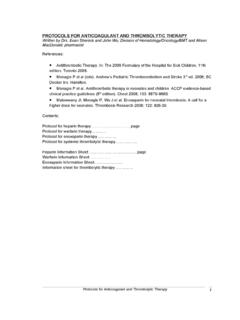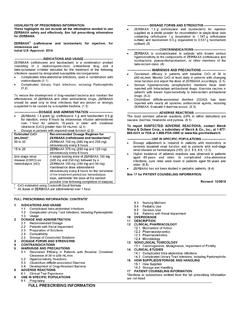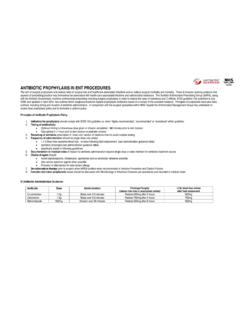Transcription of 130225 4 Clean version Data Sheet - Medsafe …
1 metronidazole New Zealand data Sheet metronidazole data Sheet 25 February 2013 Page 1 of 14 Baxter metronidazole metronidazole intravenous infusion 500mg/100mL (Viaflex Minibag) DESCRIPTION metronidazole is 1-(2-hydroxyethyl)-2-methyl-5-nitroimida zole It appears as a white to brownish cream crystalline substance with melting point 159-162 C. Solubility in water at 20 C is 1g/100mL; in ethyl alcohol, ; in chloroform, ; slightly soluble in ether and soluble in dilute acids. When reconstituted as metronidazole IV for infusion , it has a pH of between and Composition Each mL contains metronidazole 5mg, anhydrous citric acid , sodium phosphate and sodium chloride Each mL contains of sodium. Classification and Activity metronidazole is a nitroimidazole antiinfective agent which has specific activity against a number of obligate anaerobic organisms and protozoa.
2 PHARMACOLOGY Mode of Action metronidazole is bactericidal, amoebicidal and trichomoncidal. The exact mode of action has not been fully elucidated. metronidazole is reduced by low-redox-potential electron transfer proteins ( nitroreductases such as ferredoxin) to unidentified polar product(s) which lack the nitro group. The reduction product(s) appears to be responsible for the cytotoxic and antimicrobial effects of the drug which include disruption of DNA and inhibition of nucleic acid synthesis. Microbiology metronidazole is bactericidal in vitro against many anaerobic gram-negative bacilli including Bacteroides fragilis and other Bacteroides species; also other species including Fusobacterium. The drug is effective against many anaerobic gram-positive cocci including Clostridium species, Eubacterium, and anaerobic Streptococcus.
3 The MIC for susceptible anaerobes is < Serum levels higher than this are achieved at the recommended doses. metronidazole New Zealand data Sheet metronidazole data Sheet 25 February 2013 Page 2 of 14 Baxter metronidazole is also active against a wide range of pathogenic protozoa including Trichomonas vaginalis and other trichomonads, Entamoeba histolytica, Giardia lamblia, Balantidium coli and the causative organisms of acute ulcerative gingivitis. metronidazole is ineffective against both aerobic and facultative anaerobic bacteria. Pharmacokinetics Bioavailability For both oral and intravenous administration, the area under the plasma clearance curve is equivalent. Absorption Maximum plasma concentrations occur at the conclusion of the infusion after intravenous administration.
4 Traces are detected after 24 hours. The biological half-life of a single intravenously administered dose of metronidazole has been determined as hours hours. Distribution metronidazole is widely distributed in body tissues and fluids. It diffuses across the blood-brain barrier, crosses the placenta and appears in the saliva and breast milk of nursing mothers in concentrations equivalent to those found in the plasma. It attains therapeutic concentrations in the bile and the CSF. Plasma Protein Binding metronidazole is not significantly bound to plasma protein. Metabolism An oral or intravenous dose of metronidazole is partially metabolised in the liver by hydroxylation, acid side-chain oxidation and glucuronide conjugation. The major metabolite, 2-hydroxymethyl metronidazole , has some antiprotozoal activity in vitro.
5 Excretion Approximately three-fourths of a single 750mg oral dose is excreted as nitro-containing compounds (unchanged drug and its metabolites) in the urine within 5 days. Most of the remainder is excreted in the faeces. Urine may be dark or reddish brown in colour following oral and IV administration of the drug due to the presence of water-soluble pigments, which result from its metabolism. metronidazole New Zealand data Sheet metronidazole data Sheet 25 February 2013 Page 3 of 14 Baxter INDICATIONS metronidazole intravenous infusion is indicated: 1. For treatment of anaerobic infections in patients for whom oral administration is not possible. 2. When immediate anti-anaerobic therapy is required. 3. Where prophylactic cover is required at lower abdominal surgical sites presumed contaminated or potentially contaminated by anaerobic micro-organisms.
6 Procedures of this type include appendicectomy, colonic surgery, vaginal hysterectomy, abdominal surgery in the presence of anaerobes in the peritoneal cavity and surgery performed in the presence of anaerobic septicaemia. Note: metronidazole is inactive against aerobic or facultative anaerobic bacteria. CONTRAINDICATIONS metronidazole is contraindicated: 1. In patients with evidence of or a history of blood dyscrasias. (Occasionally a mild leukopenia has been observed during administration; however no persistent haematological abnormalities have been observed in animals or clinical studies.) 2. In the presence of active organic disease of the central nervous system. 3. In patients who are hypersensitive to metronidazole or other nitroimidazoles. PRECAUTIONS metronidazole has been shown to be carcinogenic in mice and rats.
7 Its use, therefore, should be reserved for the conditions described in the Indications section. Central and Peripheral Nervous System Effects Encephalopathy and peripheral neuropathy: Cases of encephalopathy and peripheral neuropathy (including optic neuropathy) have been reported with metronidazole . Encephalopathy has been reported in association with cerebellar toxicity characterised by ataxia, dizziness and dysarthia. CNS lesions seen on MRI have been described in reports of encephalopathy. CNS systems are generally reversible within days to weeks upon discontinuation of metronidazole . CNS lesions seen on MRI have also been described as reversible. metronidazole New Zealand data Sheet metronidazole data Sheet 25 February 2013 Page 4 of 14 Baxter Peripheral neuropathy, mainly of sensory type has been reported and is characterised by numbness or parenthesia of the extremities.
8 Convulsive seizures have been reported in patients treated with metronidazole . Aseptic meningitis Cases of aseptic meningitis have been reported with metronidazole . Symptoms can occur within hours of dose administration and generally resolve after metronidazole therapy is discontinued. The appearance of abnormal neurological signs and symptoms demands the prompt evaluation of the benefit/risk ratio of the continuation of therapy. Candidiasis Fungal overgrowth of the gastrointestinal or genital tract may occur during the metronidazole therapy and require treatment with an antifungal drug effective against candida. Long Term Therapy If metronidazole is administered for more than ten days, it is recommended that haematological tests, especially total and differential leucocyte counts, be carried out regularly and that patients be monitored for adverse reactions such as peripheral neuropathy.
9 If leukopenia or abnormal neurological signs occur, the drug should be discontinued immediately. Surgical Drainage Use of metronidazole does not obviate the need for drainage of pus whenever indicated such as in amoebic liver abscess or abscess in other accessible positions. Sodium Retention Administration of solutions containing sodium ions may result in sodium retention. Care should be taken when administrating metronidazole IV to patients receiving corticosteroids or patients predisposed to oedema. Refer to Interactions with other Drugs section. Impaired Renal Function In patients being haemodialysed twice weekly, metronidazole and its major metabolite are rapidly removed during an eight hour period of dialysis, so that the plasma concentration quickly falls below the therapeutic range.
10 Hence a further dose of metronidazole would be needed after dialysis to restore an adequate plasma concentration. In patients with renal failure, the half-life of metronidazole is unchanged, but those of its major metabolites are prolonged 4-fold or greater. The accumulation of the 2-hydroxymethyl metabolite could be associated with side effects and metronidazole New Zealand data Sheet metronidazole data Sheet 25 February 2013 Page 5 of 14 Baxter measurement of its plasma concentration by high pressure liquid chromatography (HPLC) has been recommended. In the absence of haemodialysis, the plasma clearance and elimination half-life of metronidazole are equivalent to those in patients with normal renal clearance so dosage adjustment is not necessary.














